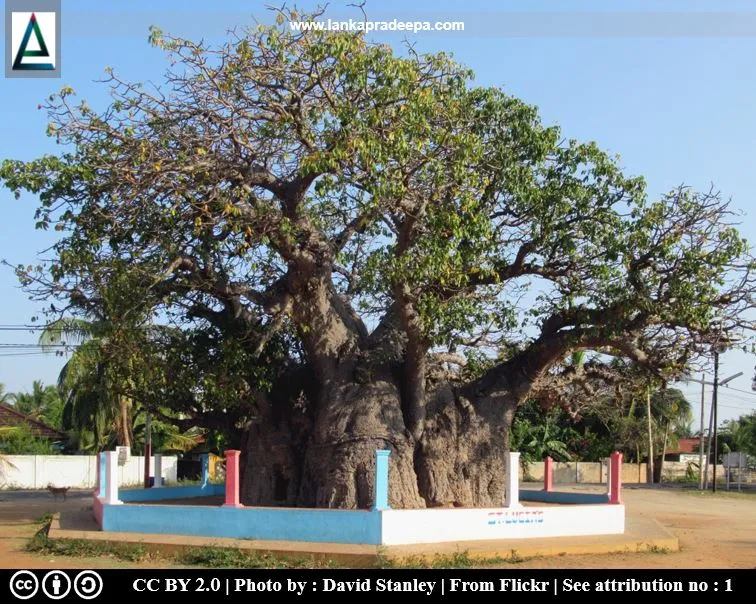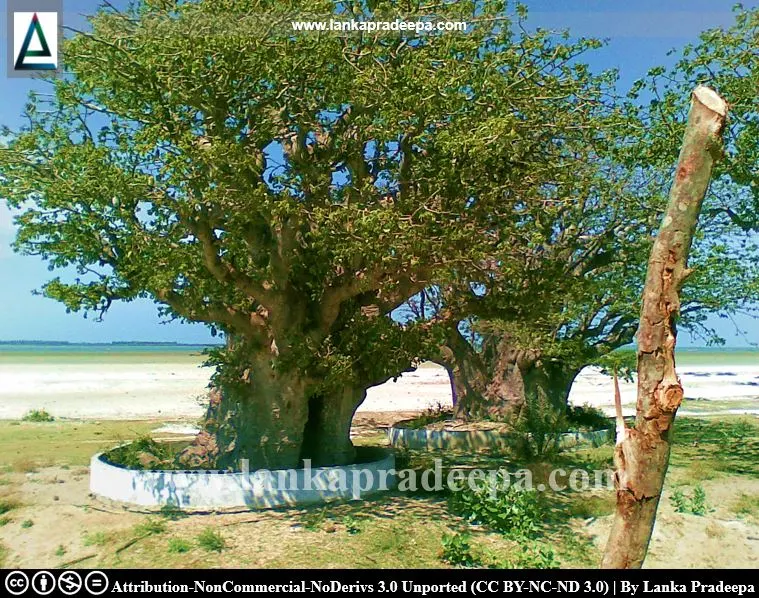
The Baobab tree (Adansonia digitata L.) located in Pallimunai, Mannar District (Sinhala: මන්නාරම බයෝබැබ් ගස), is reputedly one of the oldest and largest trees in Sri Lanka, with local belief suggesting that it was planted in the 15th century by Arabian sailors who visited the island (Asanga & Nishantha, 2018). The tree stands at approximately 7.5 meters in height and boasts a girth measuring about 19.51 meters (Asanga & Nishantha, 2018).
Baobab Distribution
African baobabs are distributed across various parts of the Indian Ocean region, including India, Sri Lanka, and coastal Pakistan (Rangan & Bell, 2015). They can also be found in the southern Arabian Peninsula and southern Iran, the Comoros islands, northwest Madagascar, and the Mascarene islands of Mauritius and Réunion (Rangan & Bell, 2015). Additionally, these baobabs are present in Malaysia and Indonesia. Beyond the Indian Ocean region, they extend their range across the Atlantic Ocean to the Caribbean islands and certain areas of sub-tropical South America (Rangan & Bell, 2015).
Baobab in Sri Lanka
Baobab is not native to Sri Lanka; however, several baobab clusters are found predominantly in Mannar and neighbouring areas, including Delft, Wilpattu, etc., located in the northwest of the island (Rangan & Bell, 2015; Vandercone et al., 2004). The introduction of baobab trees to Sri Lanka is believed to be associated with Arab traders. These traders likely played a role in bringing the baobab to the region (Vandercone et al., 2004). However, these beliefs do not clarify the identity of the Arab traders or elucidate their motivations for introducing an African tree that lacked recognized commercial value in the Indian subcontinent (Rangan & Bell, 2015). Meanwhile, several ancient texts written in Pali, Sinhala and Tamil indicate that the baobab tree surrounding places were famous due to naval business before the arrival of Arabians and this fact has been proved by the archaeological excavation.
The Baobab tree is referred to locally as "Aliya-gaha," meaning "elephant tree" in Sinhalese, and as "Perukka" by Tamils (Vandercone et al., 2004). According to Vandercone et al., approximately 40 baobab trees are still present in Sri Lanka, with 34 of them specifically identified on the island of Mannar (Vandercone et al., 2004). In 1890, a baobab tree measured by Trimen in Mannar had a diameter of 6 meters (19.9 meters in circumference). Also, in 1980, a baobab tree located several kilometres south of Mannar stood at 10 meters tall and had a diameter at breast height (dbh) of 5.6 meters [(17.55 meters in girth) Wickens, 2008]. In 2008 that tree had expanded to a girth of 20 meters (Wickens, 2008).
Because of its rarity, antiquity, and limited distribution, the baobab is recognized as a protected tree in Sri Lanka. (Vandercone et al., 2004).
A Protected Tree
The Baobab tree in Pallimunai village situated within the Grama Niladari Division of Pallimunai west-84 in the Mannar Divisional Secretary Division is an archaeological protected monument, declared by a government Gazette notification published on 28 April 1955.


See also
#) Historical and Memorial Trees in Sri Lanka
Attribution
1) Mannar Baobab by David Stanley is licensed under CC BY 2.0
References
1) Asanga, M. V. G. K.; Nishantha, I. P. S., 2018. Mannarama Distrikkaya (In Sinhala). Department of Archaeology (Sri Lanka). ISBN: 978-955-7457-10-9. p.68.
2) Rangan, H. and Bell, K.L., 2015. Elusive traces: baobabs and the African diaspora in South Asia. Environment and History, 21(1), pp.103-133.
3) The Gazette notification. No: 10758. 28 April 1955.
4) Vandercone, R., Sajithran, T.M., Wijeyamohan, S. and Santiapillai, C., 2004. The status of the baobab (Adansonia digitata L.) in Mannar Island, Sri Lanka. Current Science, pp.1709-1713.
5) Wickens, G.E., 2008. Baobab biology. The Baobabs: Pachycauls of Africa, Madagascar and Australia, pp.139-202.
Explore Other Nearby Attractions
Responsive esri Map
Responsive Google Map
මන්නාරම බයෝබැබ් ගස
මන්නාරම බයෝබැබ් ගස ශ්රී ලංකාවේ මන්නාරම දිස්ත්රික්කයේ පල්ලිමුනේ පිහිටා තිබේ. මෙරටට පැමිණි අරාබි යාත්රිකයින් විසින් වර්ෂ 1477දී පමණ මෙම ගස පැළ කරන්නට ඇතැයි විශ්වාස කෙරේ. මීටර 7.5 ක පමණ උසකින් යුතු ගසෙහි වට ප්රමාණය මීටර 19.51ක් වේ.
ශ්රී ලංකාවෙහි බයෝබැබ් ශාක
බයෝබැබ් (Adansonia digitata L.) යනු ශ්රී ලංකාවට දේශීය ශාකයක් නොවූවත් මන්නාරම සහ ඒ ආසන්න දිවයිනේ වයඹදිග ප්රදේශයන්හී (ඩෙල්ෆ්, විල්පත්තු වැනි) වැඩුනු බයෝබැබ් ගස් පොකුරු කිහිපයක් හමුවේ. ඒවා අරාබි යාත්රිකයින් විසින් මෙරටට හඳුන්වා දෙන්නට ඇතැයි විශ්වාස කෙරේ. බයෝබැබ් ගස සිංහලින් "අලියා ගස" ලෙසත් දෙමළින් "පෙරුක්කා" ලෙසත් හඳුන්වයි.
Vandercone සහ අනෙකුත් අය විසින් 2004 නිකුත් කරන ලද වාර්තාවකට අනූව ශ්රී ලංකාවේ බයෝබැබ් ශාක 40ක් පමණ දැකගත හැකිවන අතර ඉන් 34ක්ම මන්නාරම දිවයිනෙහි පිහිටයි. මෙම ශාකවල දුර්ලභ භාවය, පෞරාණිකත්වය සහ සීමිත ප්රදේශයක පැතිරී පැවත තිබීම යන කරුණු මත බයෝබැබ් ශ්රී ලංකාවේ ආරක්ෂිත ශාකයක් ලෙස නම් කොට ඇත.
පුරාවිද්යා ස්මාරක ශාකය
මන්නාරම ප්රාදේශීය ලේකම් කොට්ඨාශයට අයත් පල්ලිමුනේ ග්රාමයේ පිහිටි පැරණි බයෝබැබ් ගස 1955 අප්රේල් 28 දින ප්රකාශයට පත් රජයේ ගැසට් නිවේදනය මගින් ආරක්ෂිත පුරාවිද්යා ස්මාරකයක් ලෙස නම් කොට ඇත.

